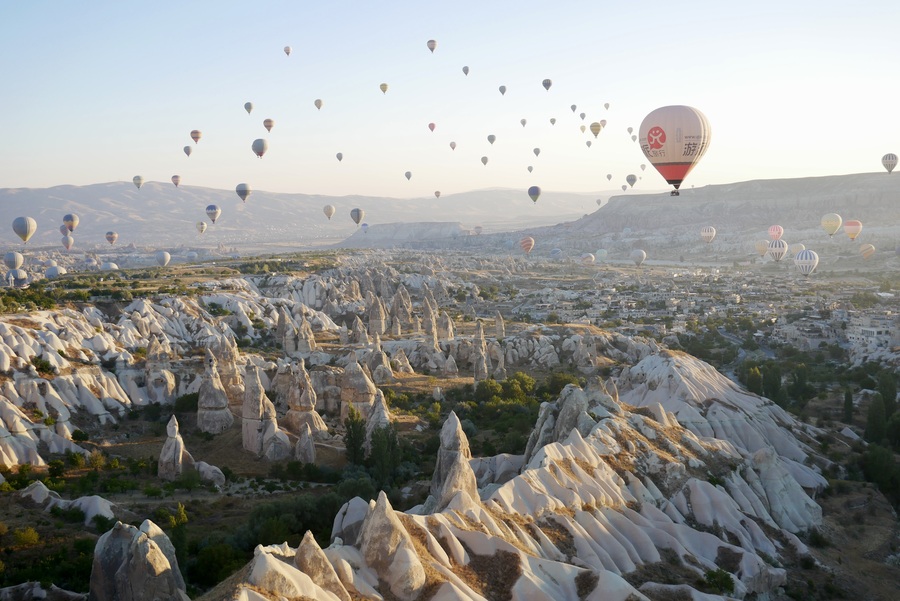
3 Days in Cappadocia Turkey: An Itinerary
Cappadocia Turkey is a whimsical fairytale destination like no other.
The outstanding region sprawls out over the stark Anatolian plains. It is a one-of-a-kind open air museum that features weather-eroded valleys, lush river canyons, rock-hewn dwellings, underground cities, and painted churches.
With its otherworldly geology and deep-rooted history, the area contains all the elements of a compelling travel destination.
Things to Do in Cappadocia in 3 Days
Cappadocia’s Unesco-recognized landscape is incredibly popular with tourists. The area reminded me of a mix between Santorini and Matera—with its hoards of Instagrammers, rich history, fancy boutique hotels, trogdolyte dwellings, and tourist-local ratio.
The bulk of Cappadocia’s attractions are located within a triangle-shaped area that lies between Ürgüp, Avanos, and Uchisar.
With three days in Cappadocia, however, you’ll be able to explore beyond the area’s ultra-concentrated tourist core and visit some of central Turkey’s unforgettable highlights—including the lush Ihlara Valley and oft-forgotten Soğanlı Valley.
Cappadocia Itinerary Day 1
Our first day in Cappadocia roughly followed the Cappadocia Green Tour itinerary. Most Green tour routes include Derinkuyu, but we chose to visit the subterranean city on day three instead.
Our Cappadocia itinerary began just west of Göreme in the town of Uchisar, before heading to the more far-flung attractions of Selime and Ihlara.
-
Cappadocia Sunrise
As the sun begins to peek over the horizon, Cappadocia Turkey is at its most magical.
In Cappadocia, early risers are rewarded with the area’s most photographed sight: hundreds of balloons filling the pastel sky above the fairy chimneys.
I’m not usually one to focus on lodging during my travels, but splurging for a balcony in Cappadocia is well worthwhile.
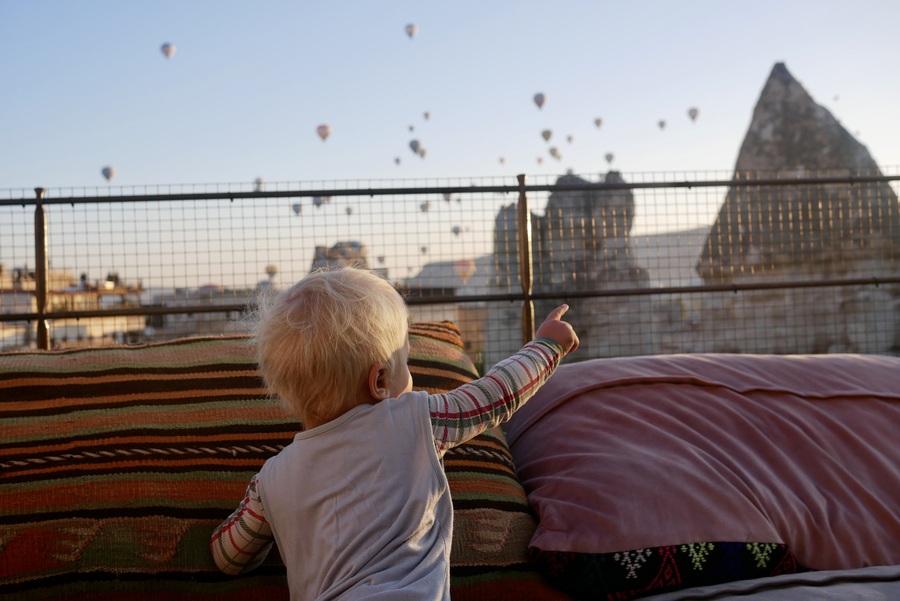
We stayed at the Century Cave Hotel in Göreme and loved everything about our stay.
-
The Uchisar Castle
Uchisar lies just west of Göreme. The town is a popular place to stay in Cappadocia due to its central location and intriguing caves.
Visible from miles around, the Uchisar Castle juts out of the surrounding landscape in a gnarled knob of caves and tunnels. The castle was used for centuries by villagers as a place of refuge when enemy armies overtook the surrounding plains.
Despite its name, you won’t find a typical stone and mortar castle at Uchisar.
Instead, the skyscraper-like mass of carved stone soars above its surroundings like a pockmarked monolith. The town of Uchisar spills down the mountainside from the rock outcrop.
The Uchisar Castle affords sweeping views of Cappadocia’s valleys from above. If you choose to skip a hot air balloon flight over the region, the rock outcrop provides your next best opportunity for aerial panoramas.
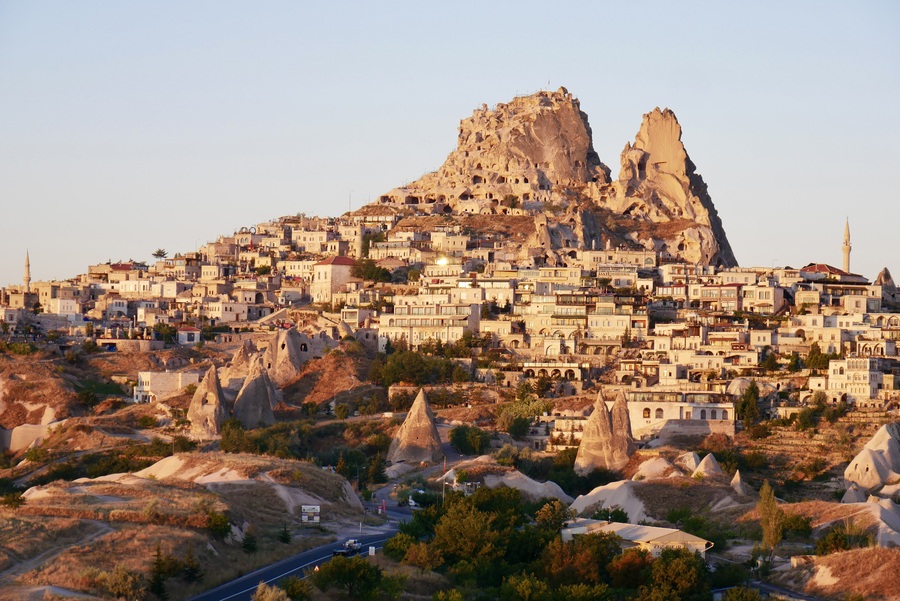
The lower reaches of Uchisar are fascinating too. You’ll find photogenic carved rock spires that resemble giant-sized gnome dwellings. Some remain abandoned, while others house gift shops or restaurants.
We spent some time wandering around the dovecotes (pigeon houses) that have been carved into the area’s hoodoos. By enticing wild pigeons with food and a safe place to roost, these houses also attracted pigeon waste, which could then be used as fertilizer.
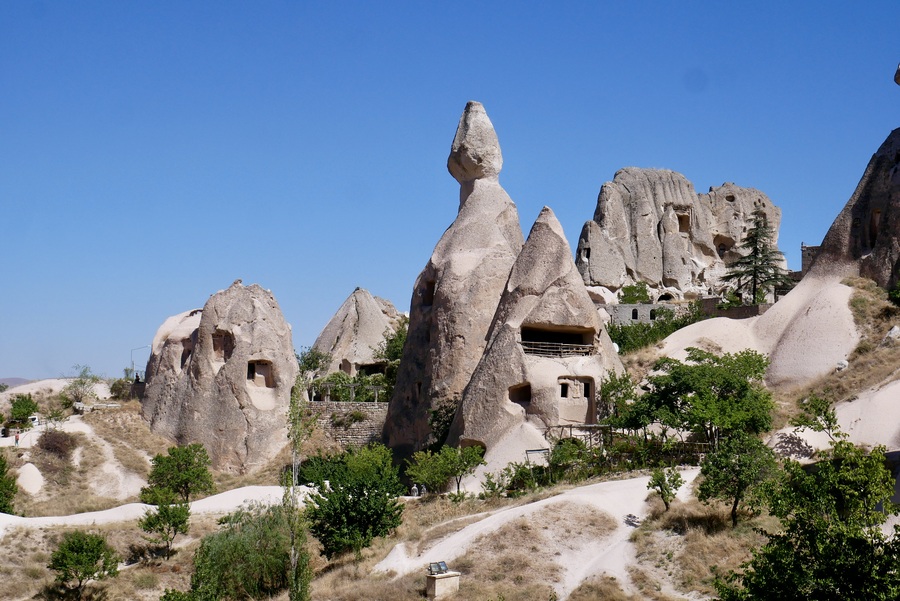
From Uchisar, you can walk to Göreme via the Pigeon Valley—a popular route that passes by rock-hewn churches, dovecotes, and abandoned cave homes.
-
Selime Cathedral
Selime is home to the largest church in Cappadocia and one of the area’s most intact collections of troglodyte dwellings. The complex is set high on a cliff face, with commanding views of the valleys and rock-hewn hoodoos below.
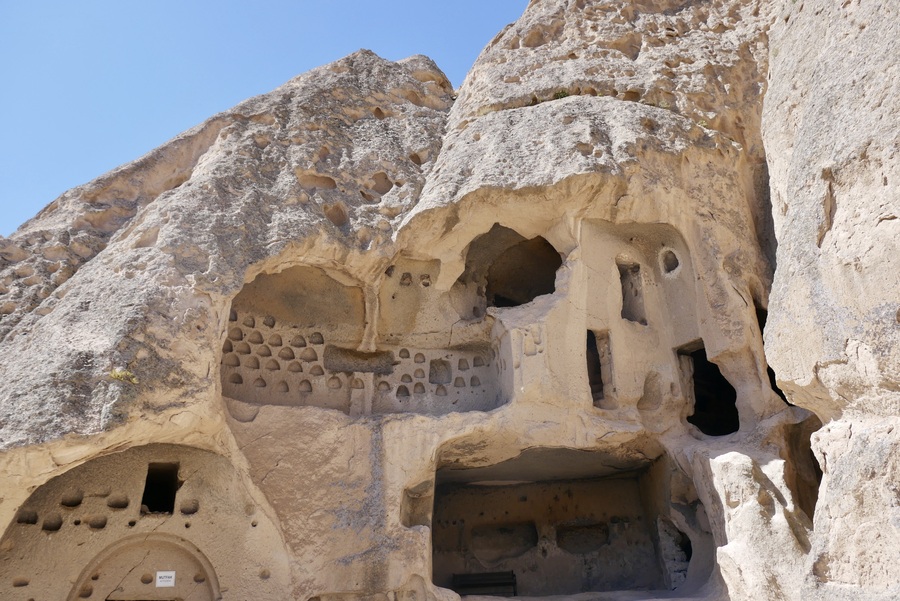
Sometimes skipped because to its out-of-the-way location, Selime is well worth visiting en-route to the Ihlara Valley. The multi-level Byzantine settlement includes livestock stalls, living quarters, kitchens, cavernous halls, and a basilica church boasting original frescoes.
A path leads up to the cathedral and caves from the parking lot and souvenir kiosks. We enjoyed scrambling up the rocks and peering into the different rock-carved rooms. I couldn’t help but be reminded of the incredible treasury in Petra Jordan when exploring Selime’s halls and churches.
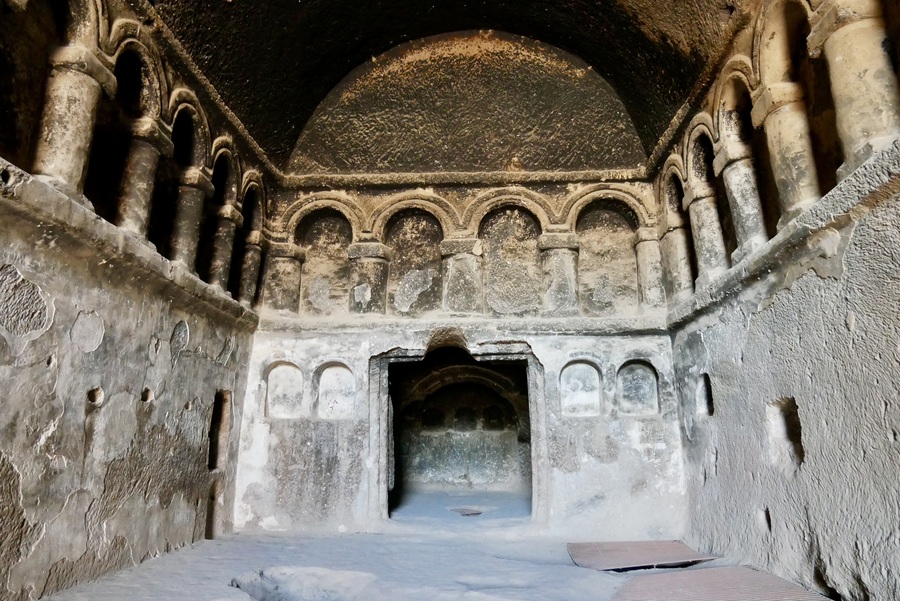
Selime Monastery dates back to the 900s. Over the centuries, different inhabitants of central Anatolia have called the area home—including the Hittites, Assyrians, Romans, Byzantines, Seljuks and Ottomans.
-
Ihlara Valley
The Ihlara Valley is one of the best hiking destinations in Cappadocia. It features a tree-lined riverbank, steep canyon walls, and rock-hewn churches with vibrant frescoes.
There are four established settlements in the Ihlara Valley. Ihlara town at the southern end, Belisirma in the middle, and Yaprakhisar and Selime at the northern end.
The Ihlara Valley hike is 13km one way. Many hikers choose to organize drop-off and pickup with a driver in order to avoid the roundtrip journey.
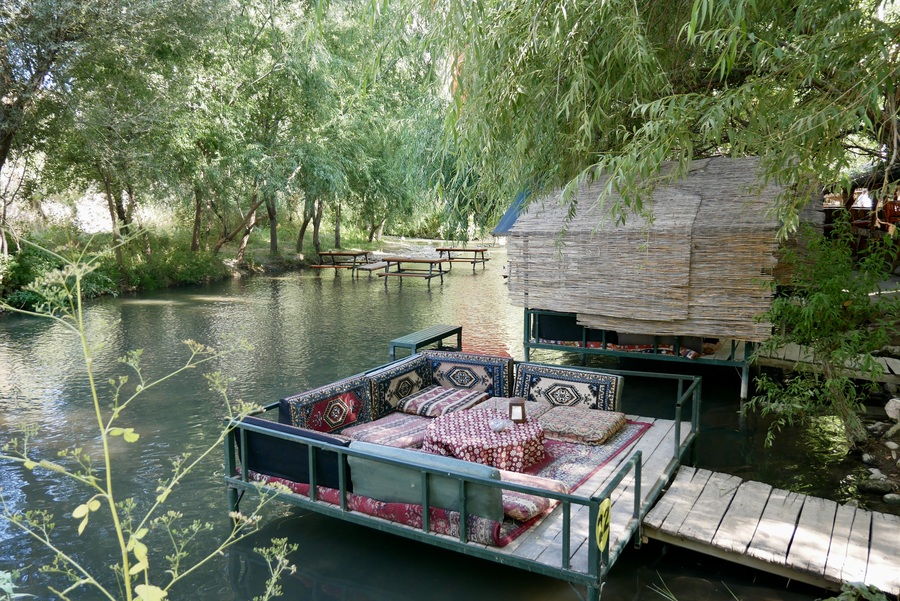
The gentle Ihlara Valley hike follows a shaded path along a tree-lined river. Even ignoring the cultural significance of our surroundings, we enjoyed the area’s natural setting. Birds chirped overhead, while leafy trees provided respite from the harsh Anatolian sun.
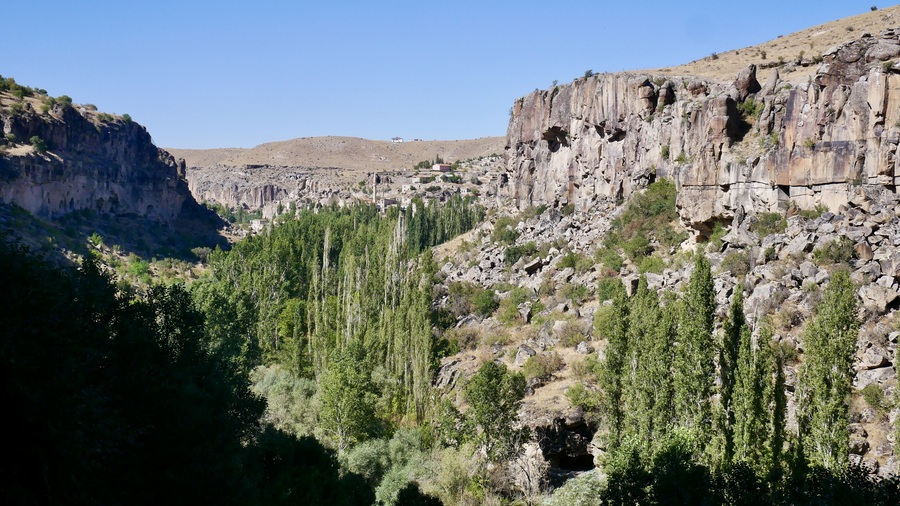
The Ihlara Valley is beautiful, but the area’s true highlights lie chiseled in the towering canyon walls.
Devout Byzantine monks fashioned cave churches in the walls of the valley. These churches—including the Snake Church and Church of St George—boast vivid frescoes that are among the most impressive in Cappadocia.
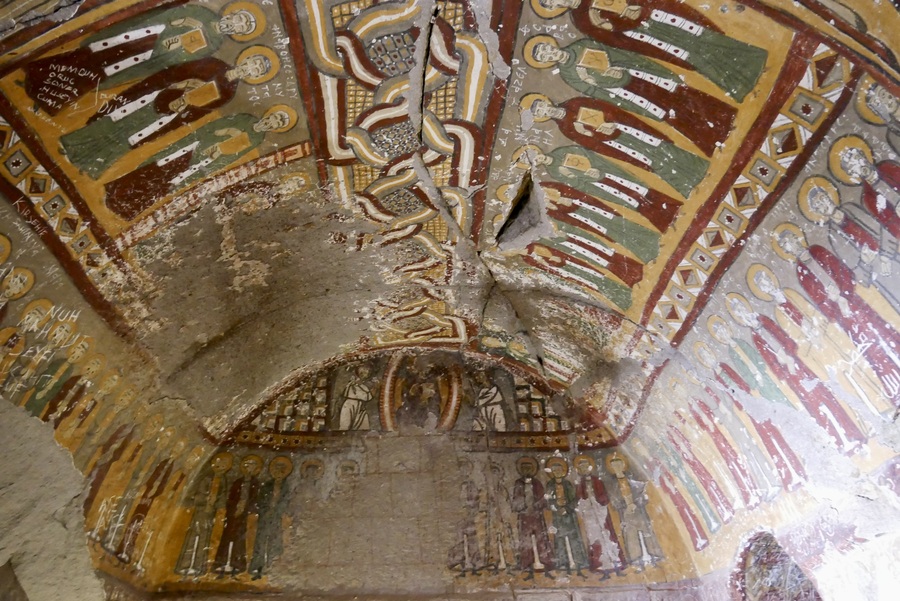
-
Güzelyurt
Rick Steves speaks highly of Güzelyurt. It’s his favorite spot in Cappadocia, so we had intended to visit the town to see what the fuss was about.
Güzelyurt lies at the end of the Ihlara Valley. It is relatively off the beaten path in terms of tourism and still has a very local and traditional feel.
Unfortunately, our arrival in Güzelyurt coicided with Elio’s car nap so, we decided to proceed onward to Göreme when we passed through the town.
If you have time, you can stop by Güzelyurt on day one of your Cappadocia itinerary.
-
Sunset Hill
Sunrise may be what Cappadocia is most known for, but sunset in the area is beautiful too.
You won’t see colorful balloons filling the skies at sunset, but you’ll nonetheless witness the way in which the setting sun paints the area’s fairy chimneys with varying shades of orange, pink, and red.
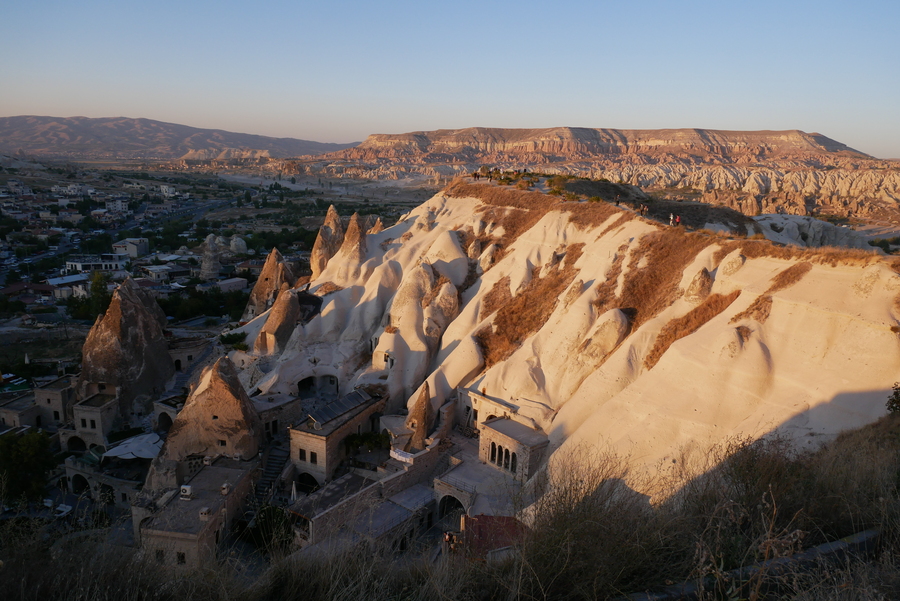
Located just behind the town of Göreme, you can reach the spot by climbing up Aydin Kiragi Street. A path along the ridgeline showcases panoramas of the town and its surroundings from above.
Cappadocia Itinerary Day 2
Our second day in Cappadocia included the main attractions that lie at the heart of Cappadocia.
If you only have one day in Cappadocia, I recommend focusing on the sites and activities listed below.
-
Hot Air Balloon
Cappadocia is incredible from ground level, but soaring above its rock spires and hoodoos offers an entirely different perspective of the fairytale wonderland.
Hot air balloons are a central part of the Cappadocia experience. The area ranks among the world’s most famous hot air balloon destinations. Other noteworthy ballooning destinations include the Sarengeti in Tanzania, Bagan in Myanmar, the Valley of the Kings in Egypt, and Teotihuacan in Mexico.
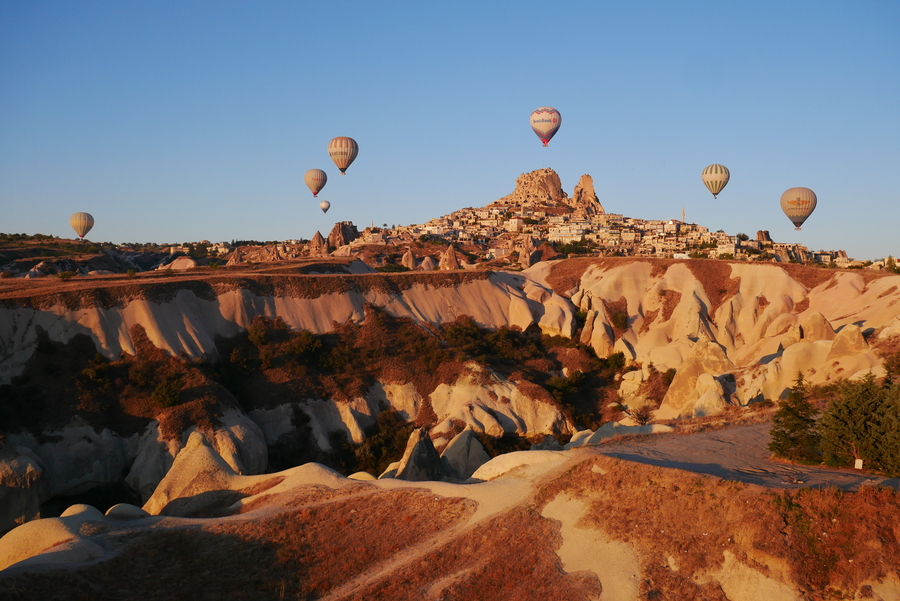
Despite its hefty price tag, riding in a hot air balloon was near the top of my Cappadocia bucket list. I’d previously ridden in a balloon over the Valley of the Kings in Luxor Egypt. The experience was so magical that I didn’t think twice about booking a tour in Cappadocia.
Hot air balloon tours of Cappadocia begin in the wee hours of the morning. Our tour picked us up at our hotel at 5am.
By 5:30, we were watching as our crew filled our balloon and prepared to launch us into the sky. Shortly after, we were soaring above the fairy chimneys, as our pilot expertly navigated the balloons between rocky outcrops.
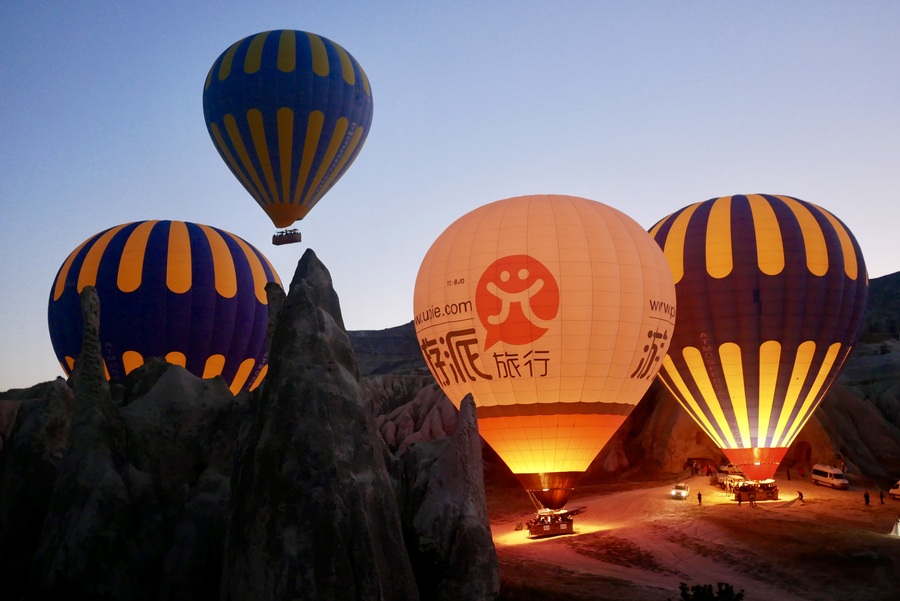
From our basket, we had great views of the surreal landscape framed against the sunrise. It was a trip that managed to be both thrilling and serene.
If you’re spending three days in Cappadocia, I recommend booking your hot air balloon tour on days one or two. Try to avoid waiting till the last opportunity, in case of weather cancellations.
-
Love Valley
If you love hiking, then you’ll have no shortage of places to explore in Cappadocia.
In Love Valley, the name leaves little to the imagination. The hoodoos in Love Valley are some of the most recognizable in the area. They jut out of the ground like enormous phalluses pointing into the sky.
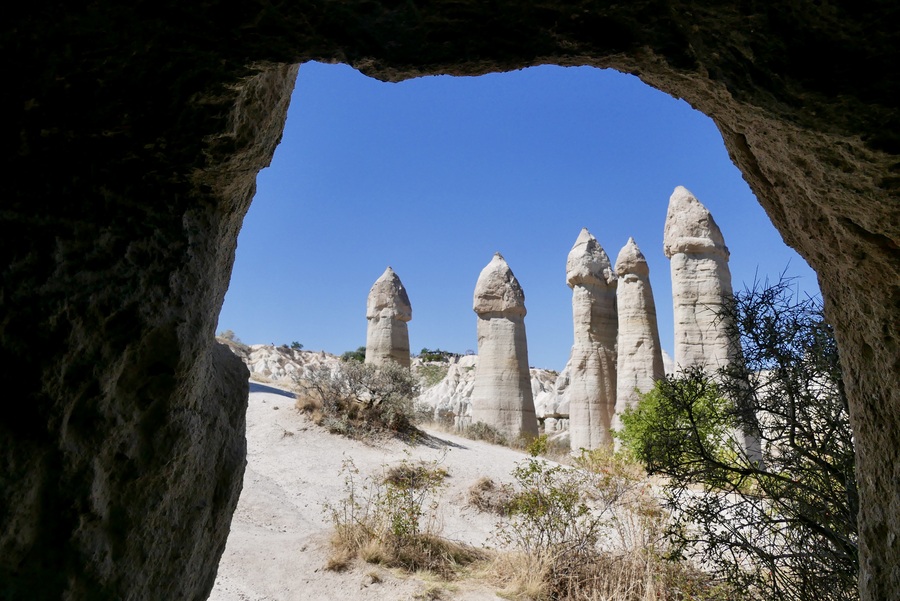
When we plugged “Love Valley” into Google Maps, we found ourselves at a viewpoint that boasts unencumbered aerial panoramas of the valley and its surroundings. You can walk along the lookout’s ridgetop, but there is no way to access the valley floor from the parking area.
To hike amidst the penis-shaped rocks, you’ll have to find the Love Valley trailhead, located about 2km from the lookout point.
-
Çavuşin
The village of Çavuşin is a prominent stop along the road that connects Göreme with Avanos.
Çavuşin once housed a large Orthodox Christian population, before the Greece-Turkey population exchange in 1923 essentially cleansed the area of its residents. The population exchange in Çavuşin saw a large exodus from town, while a relatively small population of immigrants moved in. Houses in the area began to fall into disrepair, exacerbated by a landslide in 1950 that forced the evacuation of the village’s remaining residents.
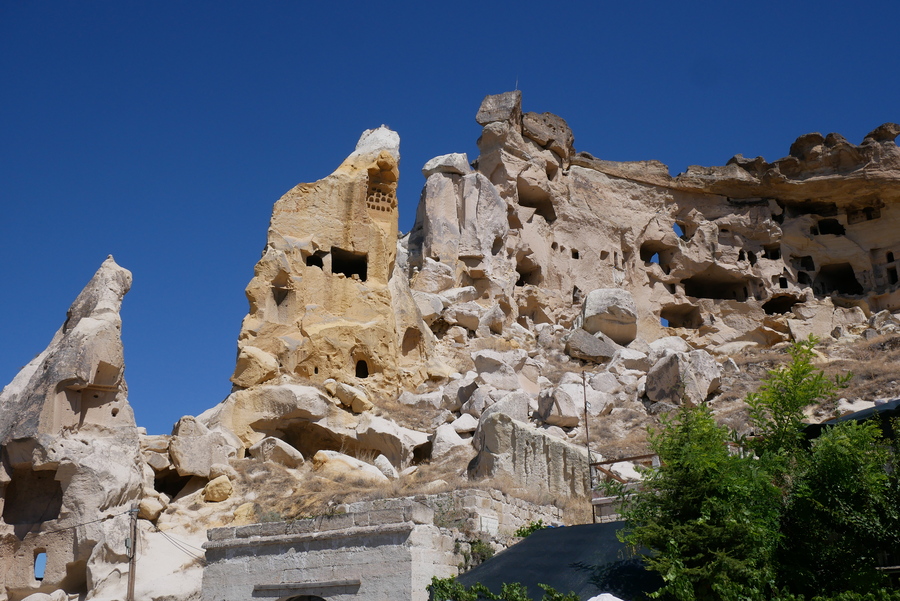
Çavuşin Village boasts houses that are carved into the surrounding rock formations. These structures have been shaped and eroded by natural elements like rain, wind, and earthquakes.
To reach the top of the village, visitors can follow a winding path that affords breathtaking views of Red Valley and Uchisar Castle. At the village’s highest point, you’ll find a 5th century church that is among the oldest in Cappadocia.
-
Zelve Open Air Museum
The Zelve Open Air Museum is probably the top Cappadocia attraction that we omitted from our itinerary. The Zelve Valley was the earliest-settled and last-abandoned monastic valley in Cappadocia.
Zelve’s churches are not as plentiful or as impressive as those at the more famous Göreme Open Air Museum, but the historical site is a slightly less crowded alternative.
We skipped the Zelve Open Air Museum due to poor planning.
However, if you’re hoping to check out all the top Cappadocia attractions, you can certainly squeeze the Zelve Valley into your day 2 itinerary.
-
Imagination/Devrent Valley
Devrent Valley, als known as Imagination Valley, lies between Avanos and Ürgüp. Full of unique rock formations, it is easily-accessible valley is worth stopping by—whether for a quick photo opportunity, or for a longer hike in the area.
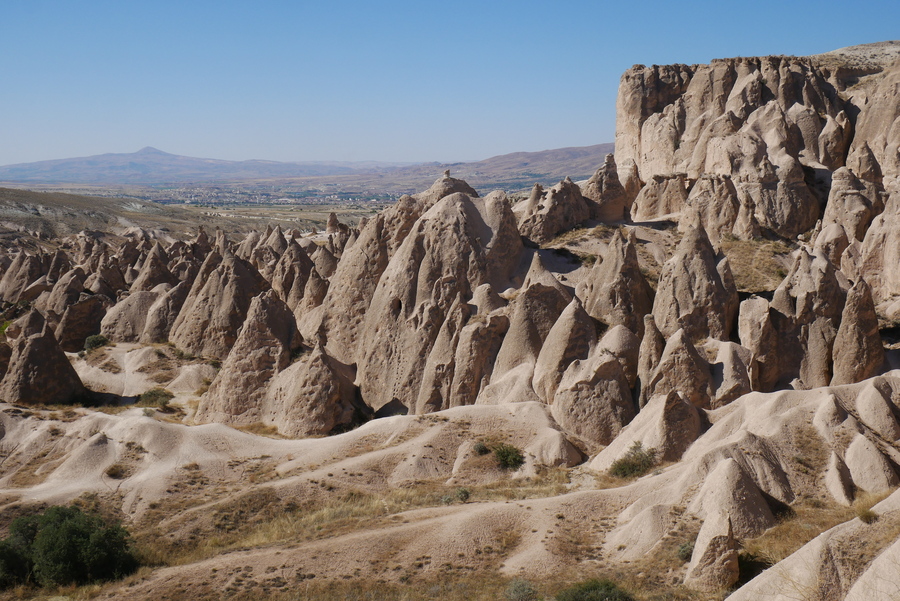
Most travelers stop by the Devrent Valley in order to get photos of the balancing rock spires that vaguely resemble a camel.
We stopped by for a quick photo op and quickly realized that the area deserves more than a passing glance.
There is no public transportation between Cappadocia’s cities and the Devrent Valley, but tour buses frequently stop in the area.
-
Rose and Red Valleys
The Rose Valley offers some of the best hiking experiences in Cappadocia.
Hiking routes take you past trogdolyte dwellings, around hoodoos and rock spires, and to beautifully preserved churches.
If you have time, you can also continue on into the Red Valley.
The Rose and Red Valley hikes are one way, which can make them logistically challenging if you have your own transport or limited time.
Hiking the Red Valley around sunset will showcase the area’s vibrant hues.
-
Ürgüp Turkey
Ürgüp is one of the larger towns in the Cappadocia region. Only fifteen minutes from Göreme and smack in the middle of Cappadocia’s attractions, it is a fine base from which to explore the region. Ürgüp is home to a smattering of boutique hotels, some cave dwellings, and a lively central core.
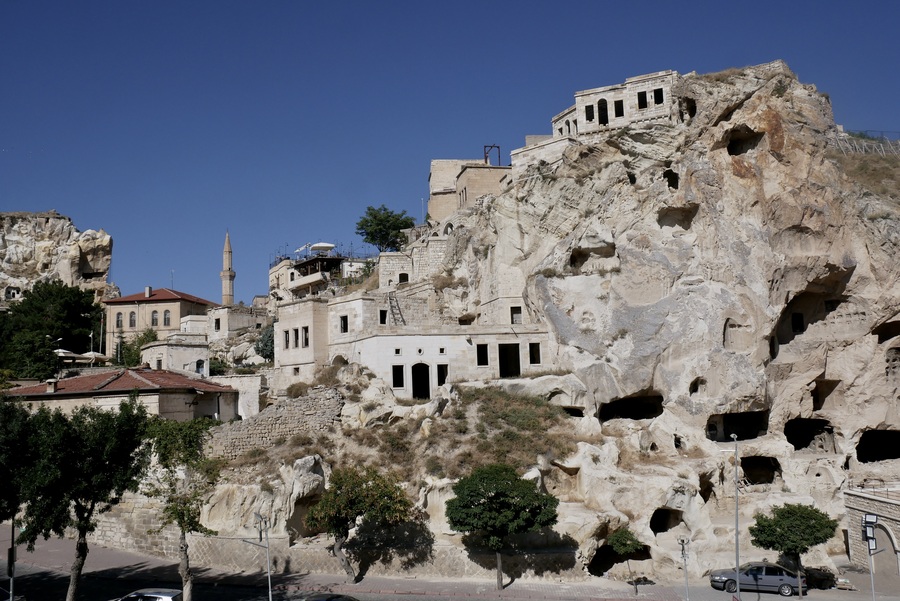
Ürgüp feels more local than some of the Cappadocia’s other population centers. While hotels and guesthouses seemed to outnumber local residences in Göreme and Uchisar, Ürgüp still felt like an inhabited Turkish town.
-
The Three Beauties
The Three Beauties—a collection of rock-capped fairy chimneys overlooking a sweeping valley—comprise Ürgüp’s most famous landmark.
One of the most important symbols of Cappadocia, the fairy chimney cluster of two adults and a child takes its name from local legend.
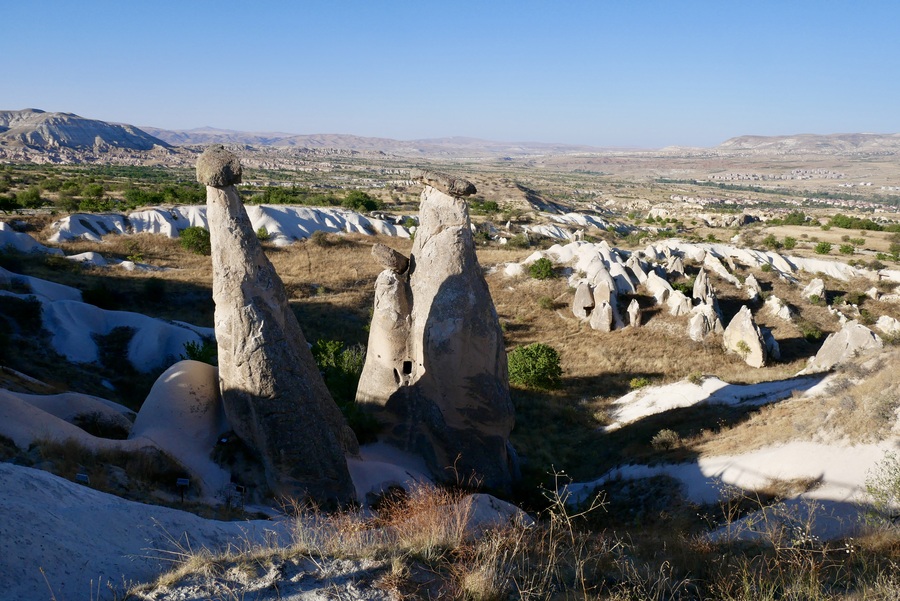
According to lore, a young princess fell in love with a shepherd. Despite her father’s disapproval, the princess married the shepherd anyway, and had his child.
The angry king set out for revenge. Realizing that her family would die, the princess made a plea to Allah for salvation. Allah accepted this prayer and turned the princess, the shepherd, and their child into stone.
Cappadocia Itinerary Day 3
With our third day in Cappadocia, we hit some of the area’s most renowned attractions, as well as one of its most off-the-beaten-path gems.
We started at the fascinating underground city of Derinkuyu, before escaping the crowds in the Soğanlı Valley.
Finally, we stopped by Ortahisar en-route to Cappadocia’s finest cluster of cave churches.
-
Derinkuyu or Kaymakli
There are two main underground cities in Cappadocia: Derinkuyu and Kaymakli.
Derinkuyu is the largest subterranean city in Cappadocia, and the one we visited on our trip. Its passages date back to the the 7th century BC, though they fully formed in the Byzantine era.
During the Arab-Byzantine wars (780-1180AD) the underground city was used as protection from Arab Muslims.
At its peak, Derinkuyu was large enough to house 20,000 people.
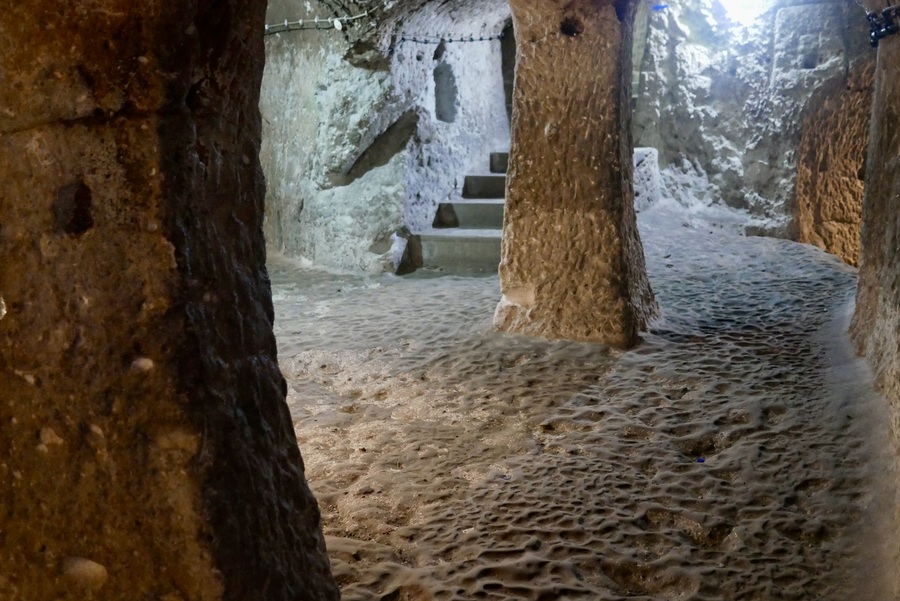
A 9km-long underground tunnel once linked Derinkuyu and Kaymakli.
Today, however, you won’t be able to travel underground between the cities, and each requires a separate fee to enter.
-
Soğanlı Valley
The Soğanlı Valley lies about 30 minutes south of Ürgüp. It is an offbeat gem and one of my favorite places to visit in Cappadocia.
Soğanlı is a remote valley with courtyard monasteries and cave churches from the 10th and 11th centuries.
The ancient rock-cut village has nearly two dozen churches. The valley cliffs also include Roman-era tombs and hundreds of pigeon houses.
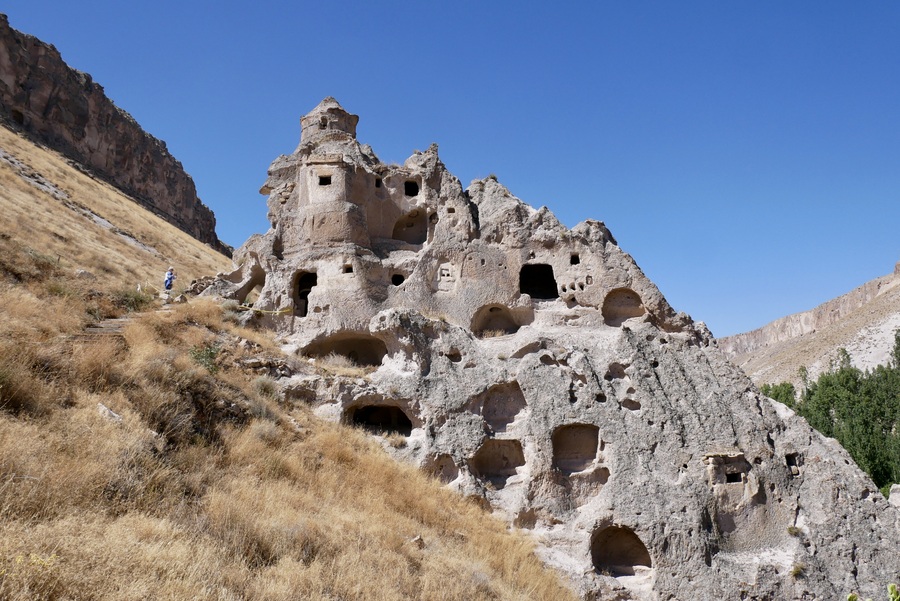
The Soğanlı Valley was the most surprising place we visited during our three days in Cappadocia.
We had high expectations when visiting the area’s more popular tourist destinations.
But for the Soğanlı Valley, we had no expectations.
The area blew us away.
-
Ortahisar Turkey
Ortahisar is a Cappadocian town that surrounds an iconic rock castle. It resembles Uchisar in many ways, but receives far fewer visitors.
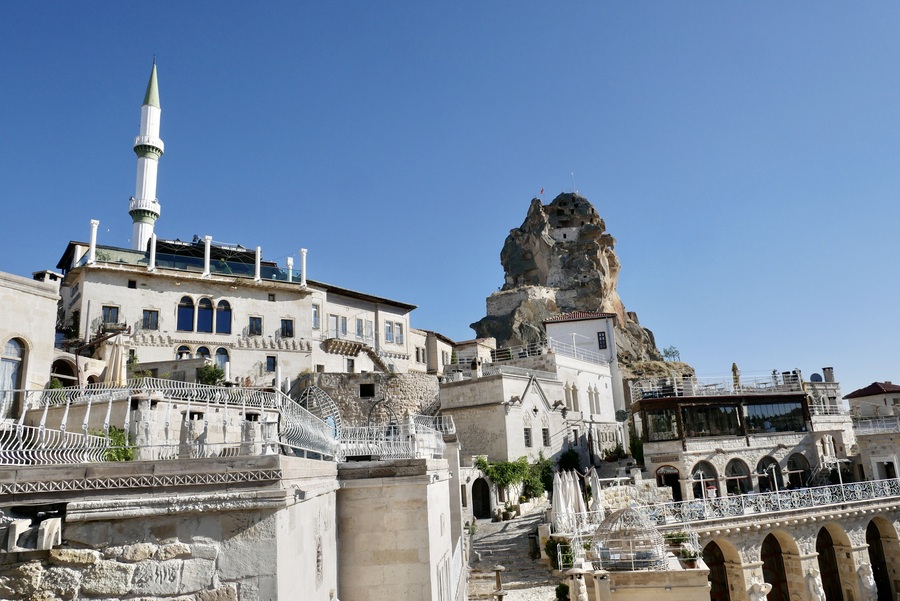
We didn’t climb to the top of the Ortahisar Castle since we still wanted to ensure we had ample time to visit the Göreme Open Air Museum.
Nonetheless, we found that soaking in the views of Ortahisar’s iconic rock outcrop was worth the small detour.
-
Göreme Open Air Museum
The Göreme Open Air Museum contains the most renowned cluster of rock-hewn churches in Cappadocia. Consequently, it is also the most crowded. The splendid grouping of monastic Byzantine churches and chapels lies just outside of the Göreme city center. It is the crown jewel of Cappadocia’s Christian heritage.
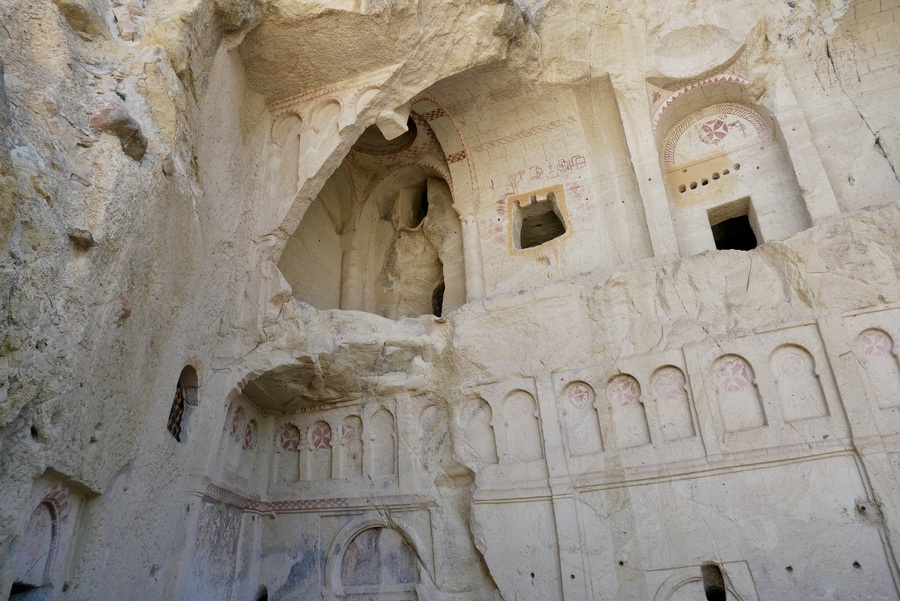
Göreme has a particularly high concentration of painted cave churches. The churches in the open air museum are adorned with beautiful frescoes. The highlight of the open air musuem is the Dark Church (Karanlık Kilise), with its particularly stunning interior.
You’ll have to pay an additional fee to access the Dark Church. Photos are not allowed.
Where to Stay in Cappadocia
Though I won’t deny the appeal of staying in a nice hotel, I’m not generally one to prioritize accommodations in my travels.
But Cappadocia is different.
There’s something special about staying in a cave hotel with terrace views. The ability to watch Cappadocia’s famous sunrise from a balcony is worth the splurge.
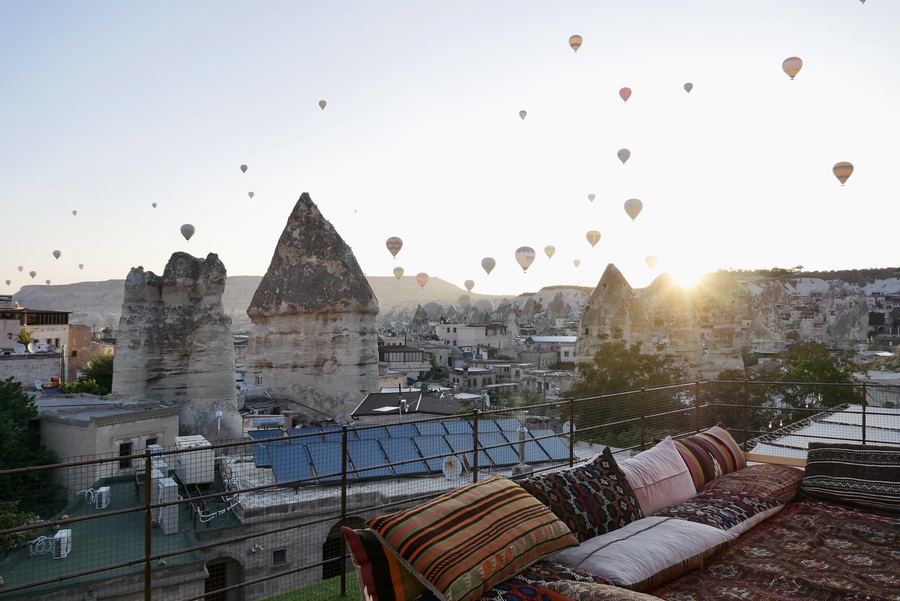
We stayed at the Century Cave Hotel during our trip to Cappadocia. The hotel’s convenient location, balcony views, delicious buffet breakfast, and wonderful staff truly helped make our sojourn memorable.
If a cheap price is what you’re after, My Home Cappadocia Stone House Hostel fits the bill for being clean, convenient, and affordable.
For a step up in comfort, the Chelebi Cave House Hotel and Lunar Cappadocia Hotel receive excellent ratings.
Cappadocia Tours
Tours are a popular way of visiting Cappadocia due to the area’s lack of public transportation. Popular routes include the red and green tours.
-
The Red Tour
The red tour in Cappadocia is a favorite option for visitors who only have one day in the area. Though each tour on the red route differs slightly, most offer a combination of the Göreme Open Air Museum, Love Valley, and Uchisar.
-
The Green Tour
The green tour usually covers one of the underground cities, the Ihlara Valley, and Selime. It is a fantastic option to combine with the red tour if you only have two days in Cappadocia.
How Many Days Should You Spend in Cappadocia?
With limited time, you’ll be able to get a good taste of the area in two days. We spent three days in Cappadocia and found our allotted time to be perfect.
Of course, an extra day would have allowed us to add a few more hikes and valleys to our itinerary.
But considering we still wanted to squeeze Istanbul, Konya, Pamukkale, Ephesus and Bodrum into our itinerary, we left after three.
With 1 Day in Cappadocia
With only one day in Cappadocia, I’d focus on the second day of my three day itinerary. You can start the day with a hot air balloon ride over the fairy chimneys and then pack in the Göreme Open Air Museum, Love Valley, and Uchisar.
With 2 Days in Cappadocia
With two days in Cappadocia, I’d follow the above itinerary for day one. For your second day, you could choose either the Ihlara Valley or Soğanlı Valley in conjunction with one of the underground cities.
With More than 3 Days in Cappadocia
If you have more than three days in Cappadocia, you’ll have time to do most of the area’s top activities. Had I had more time in central Turkey, I would have chosen to do some more hiking in the area.
Best Time to Visit Cappadocia
The best time to visit Cappadocia is during the spring (April to June) and autumn (September to November) months when the weather is pleasant and the region is less crowded. The weather during these periods is ideal for outdoor activities such as hot air ballooning and hiking.
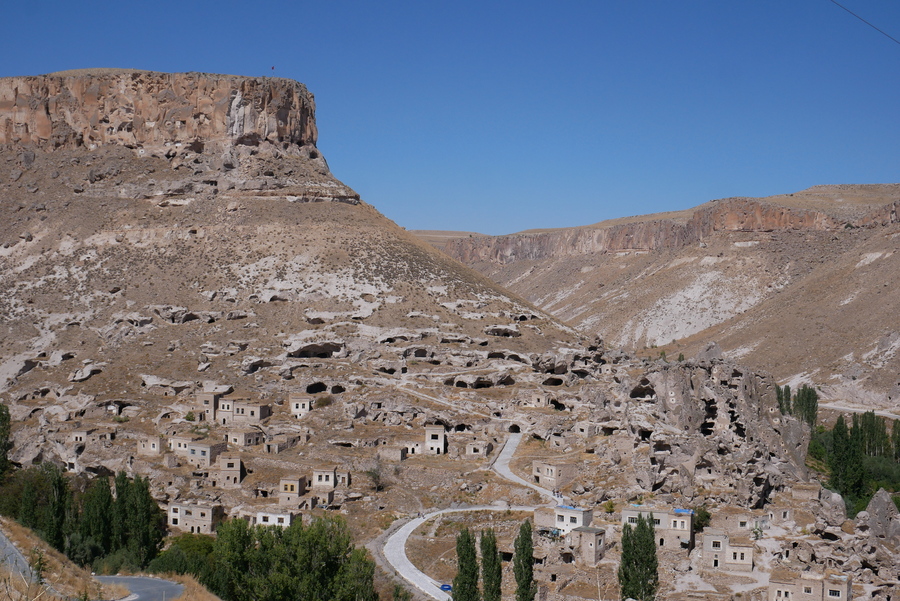
During our visit to Turkey in September, we had near-perfect weather.
Getting to Cappadocia Turkey
Due to its location within the heart of Anatolia, most travelers reach Cappadocia by bus or plane. Note that there are two main airports near Cappadocia: Kayseri and Nevşehir.
Nevşehir is the closer airport to Cappadocia’s main attractions and the preferred option if you want to limit travel time.
However, you’ll likely have more choice in and out of Kayseri in terms of flight times and prices.
Getting Around Cappadocia Turkey
The best way to get around Cappadocia is either by renting a car or by hiring a private driver. Public transport is not a viable option in Cappadocia, as sites are often far apart and poorly connected.
Tours are another popular option if you are traveling solo or do not wish to rent a car.
****
Cappadocia is a true gem. For lovers of nature and history, there are few places around the world that can compare.
The area had been on my bucket list for a long time before I got a chance to visit.
And when I finally set foot among its whimsical hoodoos and painted cave monasteries, the fairytale wonderland did not disappoint.


